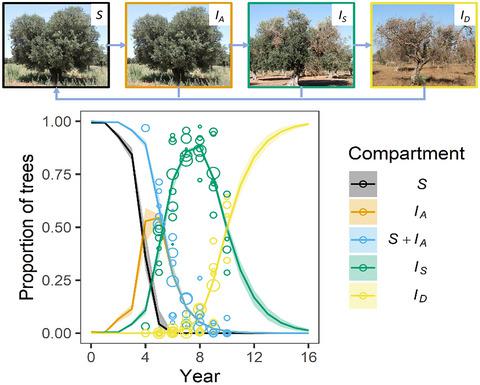当前位置:
X-MOL 学术
›
Plant Pathol.
›
论文详情
Our official English website, www.x-mol.net, welcomes your feedback! (Note: you will need to create a separate account there.)
Estimating the epidemiology of emerging Xylella fastidiosa outbreaks in olives
Plant Pathology ( IF 2.7 ) Pub Date : 2020-07-20 , DOI: 10.1111/ppa.13238 Steven M. White 1 , Juan A. Navas‐Cortés 2 , James M. Bullock 1 , Donato Boscia 3 , Daniel S. Chapman 4
Plant Pathology ( IF 2.7 ) Pub Date : 2020-07-20 , DOI: 10.1111/ppa.13238 Steven M. White 1 , Juan A. Navas‐Cortés 2 , James M. Bullock 1 , Donato Boscia 3 , Daniel S. Chapman 4
Affiliation

|
Xylella fastidiosa is an important insect‐vectored bacterial plant pathogen with a wide host range, causing significant economic impact in the agricultural and horticultural industries. Once restricted to the Americas, severe European outbreaks have been discovered recently in Italy, Spain, France, and Portugal. The Italian outbreak, detected in Puglia in 2013, has spread over 100 km, killing millions of olive trees, and is still expanding. To date, quantified assessment of important epidemiological parameters useful for risk assessment and management, such as transmission rates, symptomless periods, and time to death in field populations, has been lacking. This is due to the emergent and novel nature of the outbreak and length of time needed to monitor the course of disease progression. To address this, we developed a Bayesian method to infer epidemiological parameters by fitting and comparing compartmental epidemiological models to short snapshots of disease progression observed in multiple field plots. We estimated that each infected tree with symptoms is able to infect around 19 trees per year (95% credible range 14–26). The symptomless stage was estimated to have low to negligible infectivity and to last an average of approximately 1.2 years (95% credible range 1.0–1.3 years). Tree desiccation was estimated to occur approximately 4.3 years (95% credible range 4.0–4.6 years) after symptom appearance. However, we were unable to estimate the infectiousness of desiccated trees from the data. Our method could be used to make early estimates of epidemiological parameters in other emerging disease outbreaks where symptom expression is slow.
中文翻译:

估计橄榄中新出现的木杆菌爆发的流行病学
木薯是一种重要的昆虫媒介细菌植物病原体,具有广泛的宿主,对农业和园艺业产生重大的经济影响。曾经局限于美洲,最近在意大利,西班牙,法国和葡萄牙发现了严重的欧洲疫情。2013年在普利亚大区发现的意大利疫情已经蔓延了100多公里,杀死了数百万棵橄榄树,并且还在不断扩大。迄今为止,缺乏对风险评估和管理有用的重要流行病学参数的量化评估,例如传播率,无症状时期和田间人群的死亡时间。这是由于爆发的新颖性和新颖性以及监测疾病进展过程所需的时间长度。为了解决这个问题,我们开发了一种贝叶斯方法,通过拟合和比较分区流行病学模型与在多个田地中观察到的疾病进展的简短快照来推断流行病学参数。我们估计,每棵有症状的受感染树每年都能感染约19棵树(95%可信范围14–26)。据估计,无症状阶段的传染性低至可忽略不计,平均持续约1.2年(95%可信范围为1.0-1.3年)。据估计,症状出现后,树木的干燥时间约为4.3年(95%可信范围为4.0-4.6年)。但是,我们无法从数据中估计干燥树木的传染性。我们的方法可用于对症状表达缓慢的其他新兴疾病暴发的流行病学参数进行早期估计。
更新日期:2020-07-20
中文翻译:

估计橄榄中新出现的木杆菌爆发的流行病学
木薯是一种重要的昆虫媒介细菌植物病原体,具有广泛的宿主,对农业和园艺业产生重大的经济影响。曾经局限于美洲,最近在意大利,西班牙,法国和葡萄牙发现了严重的欧洲疫情。2013年在普利亚大区发现的意大利疫情已经蔓延了100多公里,杀死了数百万棵橄榄树,并且还在不断扩大。迄今为止,缺乏对风险评估和管理有用的重要流行病学参数的量化评估,例如传播率,无症状时期和田间人群的死亡时间。这是由于爆发的新颖性和新颖性以及监测疾病进展过程所需的时间长度。为了解决这个问题,我们开发了一种贝叶斯方法,通过拟合和比较分区流行病学模型与在多个田地中观察到的疾病进展的简短快照来推断流行病学参数。我们估计,每棵有症状的受感染树每年都能感染约19棵树(95%可信范围14–26)。据估计,无症状阶段的传染性低至可忽略不计,平均持续约1.2年(95%可信范围为1.0-1.3年)。据估计,症状出现后,树木的干燥时间约为4.3年(95%可信范围为4.0-4.6年)。但是,我们无法从数据中估计干燥树木的传染性。我们的方法可用于对症状表达缓慢的其他新兴疾病暴发的流行病学参数进行早期估计。


























 京公网安备 11010802027423号
京公网安备 11010802027423号